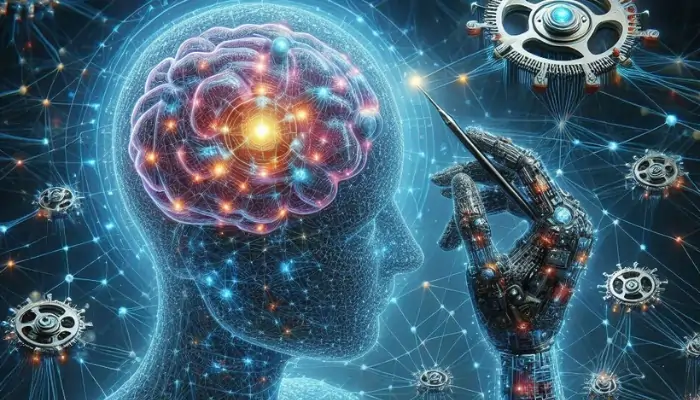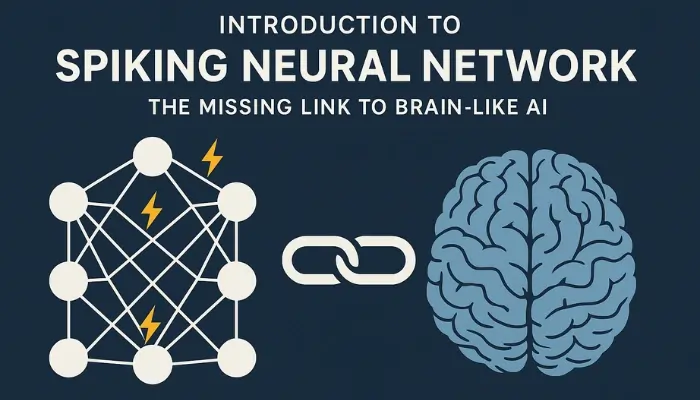When we talk about spiking neural networks and normal artificial intelligence, there is a major difference in it. The artificial intelligence that tries to mirror human intelligence wants to replicate exactly what human intelligence is, and it is developing day by day, increasing its complex neural networks.
Yet, most AI models don’t function very much like different human brains. They are trying to replicate the same as the human brain, but they aren’t, because they process all information continuously, whether it is useful at the moment or not. This leads to enormous computational power and high energy consumption, and efficiency too.
Efficiency of Spiking Neural Networks
But when we talk about spiking neural networks, it functions more like a human brain. It is very efficient, even driving and capable of processing information only when it is necessary. It doesn’t waste its energy on useless information. This only grabs the original information, which is very efficient at the moment. It doesn’t get the information which is not very important for the user.
Spiking neural network aims to achieve a way that can replicate a human brain and can perform more efficiently and responsively. It can push the AI boundaries to real-time processing and neuromorphic computing understanding. And for this, SNN is very important.
Traditional AI vs SNN
So, from the above paragraph, we can say that traditional AI has its own importance and SNN has its own. Traditional AI processes everything, all the time, every data, and SNNs just focus on what’s important at the very right moment.
So, both things are equally important, but in the upcoming time, which will be more efficient, it would definitely be SNNs. So, people just have to know more about this particular spiking neural network.
Achievements of Traditional AI
The traditional Artificial Intelligence had made many achievements and many advancements, empowering everything. You can access anything with the use of ChatGPT, Artificial Intelligence — from voice assistants to self-driving cars. You can access Artificial Intelligence everywhere.
The Challenge of Efficiency
But there is one major challenge, which is efficiency. Traditional Artificial Neural Networks can perform many calculations every step, and it is very effective also. But the main thing is, this approach consumes significant energy, and which is inefficient for real-time application.
If you think about real-life application, you must be demanding a high efficiency. And for that reason, there comes Spiking Neural Network (SNN), which offers — it is the same like Artificial Intelligence only — but it is way more intelligent in computing.
Biological Analogy: What is a Spike?
You can take an example of biological neurons, which are in our body, that communicate through a short burst of electrical signals, which can be considered as a spike.
You can take a real-life example to understand the term spike. What is a spike?
A very good example for the spike in a neural network is like clapping to get someone’s attention, like grabbing someone’s attention so that everyone’s attention comes towards one particular thing.
Consider yourself that you are in a public room and everyone is talking around you and suddenly one person stands and says that they have something important to say, they have something important to tell you, and if someone wants to make an announcement, they clap loudly to grab attention.
Then the clap which is made by an individual is called spike — a short strong signal that carries information only when needed.
Similarly, in SNNs, neurons don’t constantly send signals. They don’t send continuous signals, they just wait for the information, the appropriate information, and then send a spike to communicate. This makes SNNs faster, more efficient, and energy-saving than a traditional artificial intelligence neuron, just like how clapping only happens when necessary instead of constant noise.
Now we can take another example to understand the concept of spike:
It’s like you are sitting in a classroom and you want to grab everyone’s attention towards you, but the information you carry is very important to accumulate to all other students. So you just stand up and make a loud clap, and then suddenly everyone’s attention is on your clap.
So that sudden shock, that sudden sound produced by your clap, refers to a spike — so that is a spike.

Introduction to Spiking Neural Networks (SNNs)
Now, we are going to talk about Spiking Neural Network (SNNs). As I already told you, it is way more intelligent than the traditional Artificial Neural Network.
Like the traditional AI models, they rely on continuous mathematical operations. Whereas, when we talk about Spiking Neural Network, SNNs, it introduces us to a new way of processing information, one that is closer to how the human brain actually works. Instead of performing constant calculations, SNNs activate only when necessary. In this way, SNNs can perform calculations in a very fast way.
The Science Behind Spiking Neural Networks: How Do They Work?
1) Time Dependency
As you already know, spiking neural networks do not process continuous signals like traditional AI neural networks do. Instead, they work like a specific individual spike that occurs at a very specific moment of time. And it is time-dependent, so nature makes them unique and more similar to how biological neurons work.
To fully grasp this concept, let’s break it down into three key aspects:
What does time-dependent mean in SNNs(Spiking Neural Networks)?
In standard artificial neural networks, the neurons take numerical values in decimals like 0.4, 0.7, and pass through activation functions like sigmoid to determine the output process generated and it involves time.
However, when we talk about SNN, it is time-dependent. In neurons, it not only produces the output value, but it also generates the spikes at a very specific moment when needed. The timing of these spikes carries important information, which makes it very different from the normal standard artificial intelligence.
Instead of processing all the information in fixed steps, SNN processes the data continuously. This major aspect makes Spiking Neural Networks (SNN) dynamic and well-suited for real-time and processes the information very correctly.
2) How Do SNNs Encode Information In Time?
As we already know, the Spiking Neural Network does not send continuous signals. It relies on spikes, spikes which occur when some important information is used to decode. This helps SNN to process the data easily and efficiently just like our brain mimics the neuron.
There are three main ways to encode information in SNNs:
- Rate Coding: Based on frequency.
The more the spike, the stronger the signal.
Example: If a neuron spikes 10 times per second, it carries a strong message. - Temporal Coding: Based on timing.
The earlier the spikes, the more important is the information.
Example: If one neuron spikes before another, it might indicate that the input received is more informative. - Population Coding:
This method helps SNN to process more detailed and accurate information.
Instead of a single neuron carrying information, a group of neurons work together in a pattern.
All these methods are very important in encoding strategies, making SNN better at handling time-sensitive data. That’s why they are useful in speech recognition and real-time AI systems where timing matters.
3) How Do SNNs Become More Dynamic?
We can consider the Spiking Neural Network more dynamic than the Standard Artificial Neural Network because in the Spiking Neural Network it relies on spikes instead of processing the fixed numerical data. It relies on dynamic data, and this gives it three most important advantages:
a. Continuous Information Processing
Unlike in Standard Artificial Neural Network, where data is in fixed batches, in the Spiking Neural Network, information is continuous over time.
Example: Imagine a car which drives with the help of Artificial Intelligence (self-driving car). It can detect the obstacles as SNNs can react to changes immediately instead of waiting for the next batch of data to react. This allows SNNs to handle real-time decision making effectively.
b. Event-Driven Computation
This saves energy. SNNs only respond to the data, which is very important, rather than processing all the data constantly. It only focuses on the main concept and makes the energy efficient.
Example: A security man who uses SNNs-based systems. Rather than sitting all day in the video frame looking, with the help of an SNNs-based system, he could easily detect the movement instead of continuously analyzing video from frames like a standard Artificial Intelligence tool usually does.
This is similar to how our brain works. It’s not active all the time, but it’s active when it is necessary.
c. Better Adaptation to Real-World Signals
Since SNNs process spikes based on timing and patterns, they can adapt more easily to the real-world signals. It can detect sound, motion and sensory input.
Example: A robot using an SNNs-based operating system can adjust its grip instantly when holding a fragile object. Unlike traditional system standard Artificial Intelligence, where this might need pretty fine steps, this flexibility makes SNNs perfect for robotics, brain computers and speech recognition.
Why Does This Matter?
Because of these advantages, SNNs are widely used in neuromorphic computing. The basic major importance are:
- It is faster, it responds in real-time applications.
- It has lower power consumption for battery-powered devices.
- Smarter AI that adapts to changes dynamically.
The Future of Intelligent and Brain-Like AI
Spiking Neural Network represents a revolutionary step towards the advancement of artificial intelligence. It is a process in which the information is replicated like the human brain.
Unlike traditional neural networks, which rely on continuous and fixed static types of data, SNNs use dynamic data, which makes it faster, more efficient, and adaptive to real-world scenarios.
As SNN are based on spikes, which are more efficient to process the data, and it only allows them to compute only when the data is necessary. Significantly, it reduces energy consumption, just like our brain conserves resources by firing neurons only when needed.
Spiking Neural Networks is a very important leap towards the advancement of AI systems that process information more effectively and naturally. By sorting out the time-dependent spikes to energy efficiency, every approach to computation makes it ideal for real-time applications like robotics, neuromorphic computing, and sensory processing.
SNN offers a dynamic data structure so that it can not be considered to be fixed. As research in SNN continues to evolve, it will hold a lot of potential in the future to redefine AI’s capability to cross the limit of artificial intelligence, and will make the life much more easier with its availability — bridging the gap between artificial intelligence and biological intelligence with their ability to process data continuously and to adapt to real-world challenges and optimize power consumption.
Conclusion of Spiking Neural Networks
SNN is paving the next generation for intelligence computing. Spiking Neural Networks are redefining AI accordingly and it will bridge the gap between human intelligence and artificial intelligence. As in future, spiking neural networks will evolve, it will make AI more adaptive, efficient, and close to human intelligence. The future of the intelligent system begins here.
For more post, you can also visit:- NVIDIA’s new project

